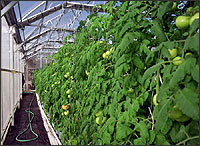Direct Use of Geothermal Energy

Greenhouse in Colorado.
Geothermal reservoirs of low-to moderate-temperature water – 68°F to 302°F (20°C to 150°C) – provide direct heat for residential, industrial, and commercial uses. This resource is widespread in the U.S., and is used to heat homes and offices, commercial greenhouses, fish farms, food processing facilities, gold mining operations, and a variety of other applications. Spent fluids from geothermal electric plants can be subsequently used for direct use applications in so-called "cascaded" operation.
Direct use of geothermal energy in homes and commercial operations is much less expensive than using traditional fuels. Savings can be as much as 80% over fossil fuels. Direct use is also very clean, producing only a small percentage (and in many cases none) of the air pollutants emitted by burning fossil fuels.
The Direct–Use Resource
Low–temperature geothermal resources exist throughout the western U.S., and there is tremendous potential for new direct–use applications. A recent survey of 10 western states identified more than 9000 thermal wells and springs, more than 900 low– to moderate–temperature geothermal resource areas, and hundreds of direct–use sites.
The survey also identified 271 collocated sites – cities within 5 miles (8 kilometers) of a resource hotter than 122 degrees F (50 degrees C) – that have excellent potential for near–term direct use. If these collocated resources were used only to heat buildings, the cities have the potential to displace 18 million barrels of oil per year!
Tapping the Resource
Direct–use systems typically include three components:
- A production facility – usually a well – to bring the hot water to the surface;
- A mechanical system – piping, heat exchanger, controls – to deliver the heat to the space or process; and
- A disposal system – injection well or storage pond – to receive the cooled geothermal fluid.
Operations Using Heat Directly from the Earth
District and Space Heating

The first modern district heating system - Oregon Institute of Technology; installed 1964.
The primary uses of low–temperature geothermal resources are in district and space heating, greenhouses, and aquaculture facilities. A 1996 survey found that these applications were using nearly 5.8 billion megajoules of geothermal energy each year – the energy equivalent of nearly 1.6 million barrels of oil!
In the U.S., more than 120 operations, with hundreds of individual systems at some sites, are using geothermal energy for district and space heating. District systems distribute hydrothermal water from one or more geothermal wells through a series of pipes to several individual houses and buildings, or blocks of buildings. Space heating uses one well per structure. In both types, the geothermal production well and distribution piping replace the fossil–fuel–burning heat source of the traditional heating system.
Geothermal district heating systems can save consumers 30% to 50% of the cost of natural gas heating. The tremendous potential for district heating in the western U.S. was illustrated in a 1980s inventory which identified 1,277 geothermal sites within 5 miles of 373 cities in 8 states.

A fish farm in Colorado.
Greenhouse and Aquaculture Facilities
Greenhouses and aquaculture (fish farming) are the two primary uses of geothermal energy in the agribusiness industry. Thirty–eight greenhouses, many covering several acres, are raising vegetables, flowers, houseplants, and tree seedlings in 8 western states. Twenty–eight aquaculture operations are active in 10 states.
Most greenhouse operators estimate that using geothermal resources instead of traditional energy sources saves about 80% of fuel costs – about 5% to 8% of total operating costs. The relatively rural location of most geothermal resources also offers advantages, including clean air, few disease problems, clean water, a stable workforce, and, often, low taxes.

Crop dehydration plant in Nevada.
Industrial and Commercial Uses
Industrial applications include food dehydration, laundries, gold mining, milk pasteurizing, spas, and others. Dehydration, or the drying of vegetable and fruit products, is the most common industrial use of geothermal energy. The earliest commercial use of geothermal energy was for swimming pools and spas. In 1990, 218 resorts were using geothermal hot water.
DOE Support
DOE's Geothermal Technology Development Program facilitates development of low–temperature resources for direct use by its support of the Geo–Heat Center at the Oregon Institute of Technology in Klamath Falls, Oregon. The Center is the primary source of data and information about all types of direct–use operations, and the experienced staff provides technical assistance to companies and individuals planning such operations.
- Types of Geothermal Heat Pump Systems
- Benefits of Geothermal Heat Pump Systems
- Selecting and Installing a Geothermal Heat Pump System

















